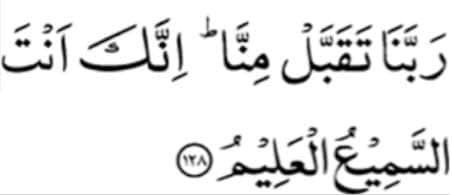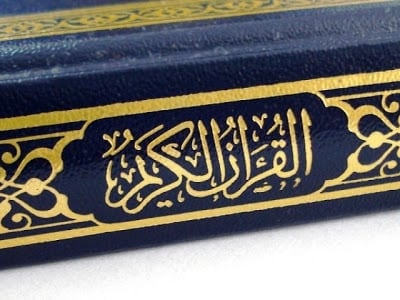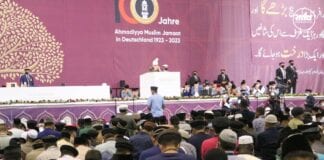By Rana Atta Ur Rehman MTA Intl.
We know that jalsa salana has officially started when we see the flag of Ahmadiyyat flying high over the jalsa site. Ahmadies watch with excited anticipation as Hadhrat Ameer ul Momineen walks down an aisle onto an elevated stage and raises a unique flag, not the standard of any one country, yet still of itself, a symbol representing many. Its black and white colours, consisting of the iconic minaret of Qadian, the Minaratul Masih (The Minaret of the Messiah), is known as Liwae Ahmadiyya, or ‘the flag of Ahmadiyyat’. This simple ceremony symbolically represents the official start of the Jalsa Salana.
Where does the concept of an official flag of the Jama’at come from?
This tradition started in 1939 on the Jalsa that marked the 50th anniversary of the inception of Jama’at Ahmadiyya, which was also the 25th anniversary of Khilafat under Hadhrat Musleh Maud (ra), the second successor of the Promised Messiah (as).
So what significance does an official flag hold in Islam?
Scholars of Ahmadiyyat such as Hadhrat Mir Mohammad Isaaq sahib (ra) informed Hadhrat Musleh Maud (ra) that the Holy Prophet (saw) offered Eid Prayers at Masjid Nabwi in Madina and a flag was hoisted at the place where Eid was being offered. A flag was also hoisted on the occasion of the final Hajj performed by the Holy Prophet (saw). Every war had a standard bearer whose duty was to uphold the flag of Islam with bravery and dignity. Another companion of the Promised Messiah (as) Hadhrat Maulvi Sayyed Mohammad Sarvar Shah Sahib, noted that the Promised Messiah (as) had seen in a vision that his community had its own flag.
Who designed and made the Liwae Ahmadiyyat?
The responsibility for manufacturing of the flag was given to Hadhrat Mirza Nasir sahib. Under the instructions of Huzoor, this ‘flag committee’ made sure that funds were received from senior companions of the Promised Messiah, (as) which were then used to purchase the needs to make home grown wool. The female companions of the time were approached so that they could churn the wool into the design which had been approved by Hadhrat Musleh Maud (ra).
Is the Flag an innovation in Islam?
A lot of people questioned the introduction of the flag. Some felt that this might represent an unnecessary innovation that could be avoided. However, Hadhrat Musleh Maud (ra) mentioned the background and history of the flag in his Khilafat Jubilee speech. He also presented the example of the Holy Prophet (saw), who himself held a flag and stated that he would give it to the person who was most deserving of it. He continued by saying, “The flag is not an innovation, whomsoever believes this to be is not fully aware of the history of Islam. I myself have heard the Promised Messiah (as) state in a gathering that our Jama’at should have a flag.”
Did the Promised Messiahas write anything regarding a flag?
The Promised Messiah (as) wrote a Persian couplet which translates as “The refuge of my flag shall be received by every lucky person”. This was another reason why Hadhrat Musleh Maud (ra) was convinced that there should be a flag to allow those who were fortunate enough, to gain refuge through this.
What prayer is recited during the Flag hoisting ceremony?
 Our Lord! Accept (this service) from us: For Thou art the All-Hearing, the All-knowing (Sura Al Baqra verse 128).
Our Lord! Accept (this service) from us: For Thou art the All-Hearing, the All-knowing (Sura Al Baqra verse 128).
What does the flag symbolise for the members of the Jama’at?
Hadhrat Musleh Maud(ra) said in his Khilafat Jubilee speech that a raised flag suggests the presence of people, whilst also serving as a source of inspiration for the younger generation.
Over the next few days we should try our best to raise our spiritual standards. We are here in the presence of a man who has been commissioned by Allah and we should strive to be able to count ourselves among those lucky souls that will gain refuge under the flag of the Promised Messiah (as).






